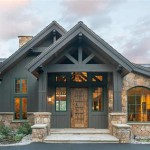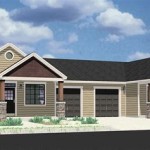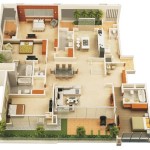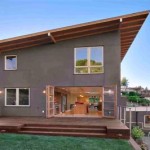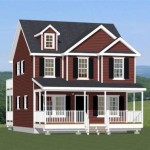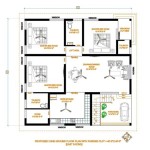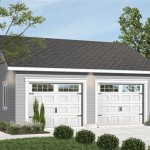One Story Farmhouse Plans With Porch: A Comprehensive Guide
The allure of the farmhouse style continues to captivate homeowners, blending rustic charm with modern convenience. The one-story farmhouse, in particular, offers accessibility and a simplified lifestyle, making it ideal for a wide range of individuals and families. A defining feature of this architectural style is often a welcoming porch, which extends the living space outdoors and provides a place for relaxation and socialization. This article delves into the intricacies of one-story farmhouse plans with a porch, examining various design considerations, architectural elements, and practical benefits.
The popularity of the one-story farmhouse plan stems from its inherent advantages. Single-level living eliminates the need for stairs, making it suitable for individuals with mobility issues, young families, and those planning to age in place. The horizontal layout promotes ease of movement and allows for a more cohesive living environment, fostering a sense of connection between different areas of the home. Furthermore, one-story construction can often be more cost-effective than multi-story buildings, simplifying the building process and potentially reducing material costs.
Key Considerations for One-Story Farmhouse Porch Design
The porch is more than just an aesthetic addition to a farmhouse; it's an integral part of the overall design and functionality. Its design should be carefully considered, factoring in elements such as size, style, orientation, and materials. The porch serves as a transitional space between the interior and exterior, acting as a buffer against the elements and creating a welcoming entry point for guests.
The size of the porch should be proportional to the overall dimensions of the house. A small porch on a large house can appear insignificant, while an overly large porch on a small house can overwhelm the facade. Consider the intended use of the porch when determining its size; a porch designed solely for entry may require less space than one intended for outdoor dining or lounging. A depth of at least eight feet is generally recommended for comfortable seating arrangements.
The style of the porch should complement the overall architectural style of the farmhouse. Common farmhouse porch styles include wraparound porches, front porches, and side porches. Wraparound porches extend around multiple sides of the house, offering panoramic views and maximizing outdoor living space. Front porches are typically located at the main entrance and provide a focal point for the home's facade. Side porches can offer more privacy and serve as a secondary entrance to the house.
Porch orientation is another crucial factor to consider. A south-facing porch will receive the most sunlight, while a north-facing porch will be shadier. East-facing porches are ideal for morning sun, and west-facing porches provide afternoon shade. Consider the climate and prevailing wind patterns when determining porch orientation to maximize comfort and energy efficiency. Overhangs and awnings can also be incorporated to provide additional shade and protection from the elements.
The materials used for the porch should be durable, weather-resistant, and aesthetically pleasing. Wood is a classic choice for farmhouse porches, offering a warm and inviting feel. However, wood requires regular maintenance to prevent rot and insect damage. Composite decking is a low-maintenance alternative that mimics the look of wood while offering greater durability. Stone or brick can be used for porch supports and flooring, adding texture and visual interest.
Details such as railings, posts, and trim can significantly impact the overall look of the porch. Simple, clean lines are characteristic of modern farmhouse design, while more ornate details can evoke a more traditional feel. Consider incorporating farmhouse-inspired elements such as turned posts, spindle railings, and decorative brackets. Proper lighting is essential for creating a welcoming and functional porch. Consider incorporating a combination of ambient, task, and accent lighting to create a warm and inviting atmosphere.
Architectural Features of One Story Farmhouse Plans
Beyond the porch, several architectural features define the one-story farmhouse style. These elements contribute to the home's overall aesthetic and functionality, creating a cohesive and charming living space.
A gabled roof is a common feature of farmhouse architecture. Gables are triangular sections of a roof that extend above the eave line, adding visual interest and creating attic space. Gables can be incorporated into the front, sides, or rear of the house, depending on the overall design. The pitch of the roof can also vary, with steeper pitches creating a more dramatic effect.
Board and batten siding is another characteristic feature of farmhouse style. This type of siding consists of wide vertical boards with narrow strips of wood (battens) covering the seams. Board and batten siding provides a clean, vertical look that is both classic and contemporary. Other siding options include horizontal lap siding, shingle siding, and a combination of different materials.
Windows are an important element of any house design, and farmhouse plans often incorporate large, multi-paned windows to maximize natural light. Double-hung windows are a classic choice, allowing for ventilation from both the top and bottom. Casement windows, which swing outward, can also be used to create a more modern look. Consider incorporating a combination of different window styles to add visual interest and functionality.
The interior layout of a one-story farmhouse is typically open and airy, with a focus on connecting different living spaces. An open-concept kitchen, living room, and dining area is a popular choice, creating a sense of flow and encouraging interaction. The placement of bedrooms and bathrooms should also be carefully considered, with a focus on privacy and convenience. A master suite with a private bathroom and walk-in closet is a common feature of farmhouse plans.
Fireplaces are often a focal point of the living room in a farmhouse. A traditional wood-burning fireplace can add warmth and ambiance, while a gas fireplace offers convenience and efficiency. Consider incorporating a mantel and surround that complements the overall style of the house. Built-in bookshelves and cabinetry can also be incorporated around the fireplace to create a cozy and inviting atmosphere.
Mudrooms are a practical addition to any farmhouse, providing a space to store coats, shoes, and other outdoor gear. A mudroom can be located near the main entrance or a secondary entrance, such as a side door or garage entrance. Consider incorporating features such as built-in storage, benches, and hooks to maximize functionality.
Benefits of a One-Story Farmhouse with Porch
Choosing a one-story farmhouse plan with a porch offers numerous benefits, extending beyond aesthetics and into practicality and lifestyle.
The accessibility of a single-story home is a major advantage, particularly for individuals with mobility issues or those planning to age in place. Eliminating stairs reduces the risk of falls and makes it easier to navigate the home. Wide doorways and hallways can also be incorporated to accommodate wheelchairs or walkers. Universal design principles can be applied throughout the house to create a comfortable and accessible living environment for everyone.
One-story homes can often be more energy-efficient than multi-story homes. Heat rises, so in a two-story home, heat can escape through the upper floors. In a one-story home, heat loss is typically less significant. Proper insulation, energy-efficient windows, and a well-sealed building envelope can further enhance energy efficiency. Consider incorporating sustainable building practices, such as solar panels or rainwater harvesting, to reduce your environmental impact.
Cleaning and maintenance can be easier in a one-story home. Eliminating stairs reduces the amount of effort required to clean and maintain the house. Exterior maintenance, such as painting and gutter cleaning, can also be easier to perform on a single-story home. Consider choosing low-maintenance materials for siding, roofing, and landscaping to further reduce maintenance requirements.
The porch provides an extension of the living space, allowing homeowners to enjoy the outdoors in comfort. It can be used for relaxing, entertaining, or simply enjoying the view. A porch can also provide shade and protection from the elements, making it a valuable addition to any home. Consider furnishing the porch with comfortable seating, outdoor lighting, and potted plants to create a welcoming and inviting space.
A one-story farmhouse with a porch offers a sense of community and connection. The porch provides a place for neighbors to gather and socialize, fostering a sense of belonging. The open layout of the house encourages interaction between family members, creating a cohesive and harmonious living environment. The farmhouse style evokes a sense of warmth, comfort, and tradition, making it a desirable choice for many homeowners.
Ultimately, the decision to build a one-story farmhouse with a porch is a personal one. However, by carefully considering the design elements, architectural features, and benefits, prospective homeowners can create a beautiful and functional living space that meets their unique needs and lifestyle.

Single Story House Plans With Farmhouse Flair Blog Builderhouseplans Com

Single Story Farmhouse Plans Blog Eplans Com

One Story Farmhouse Plans Dream Home Source

Single Story House Plans With Farmhouse Flair Blog Builderhouseplans Com

4 Bedroom 1 Story Modern Farmhouse Style Plan With Outdoor Living Area And Bonus Room Westchester Craftsman House Plans

Farmhouse Plans Simple Rustic Classic Home Designs

Stylish One Story House Plans Blog Eplans Com

Single Story House Plans With Farmhouse Flair Blog Builderhouseplans Com

Small Farmhouse Plans Associated Designs

Beautiful Small Country House Plans With Porches Houseplans Blog Com

